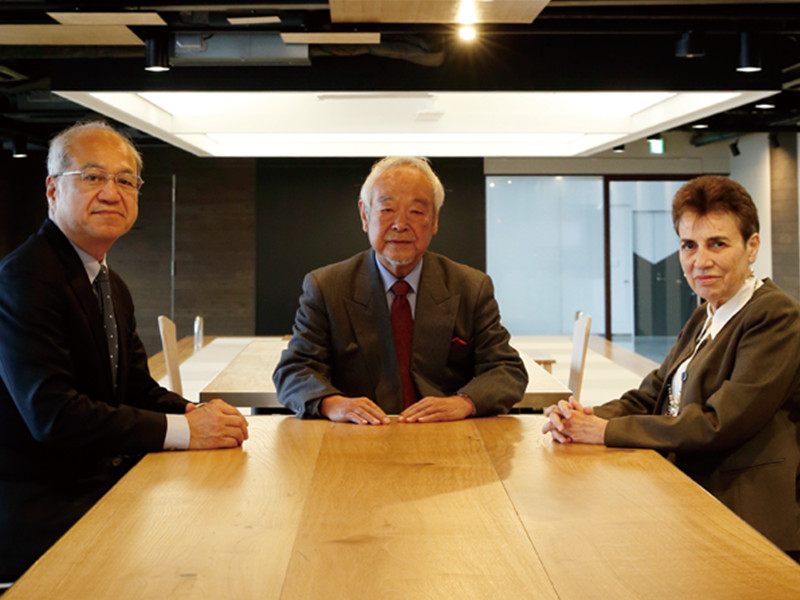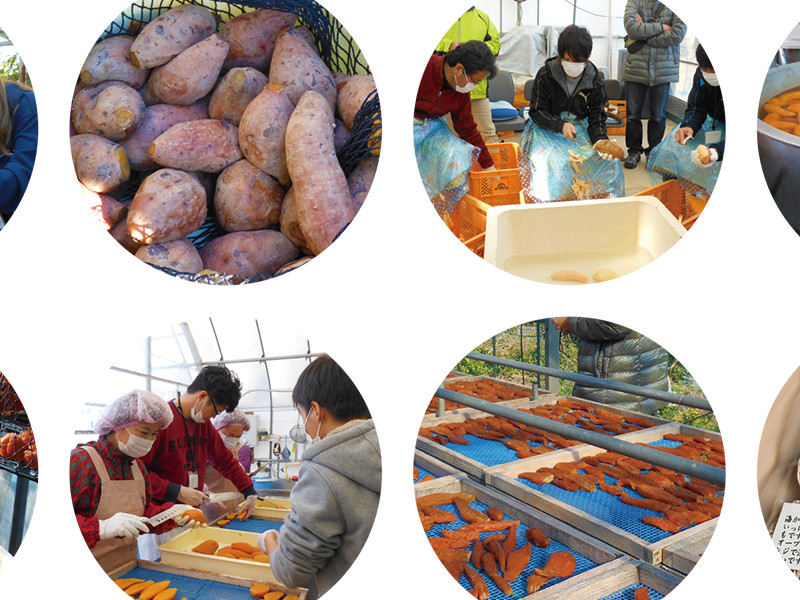STORY #9
Why is 6th Sector Industrialization in
Agriculture not Working Out?
Toyohiko Matsubara
Professor, College of Economics
Shigenori Kusuoku
Part-time Lecturer, Ritsumeikan University
Agribusiness cannot succeed without consistently covering everything from production to processing, distribution, and consumption.
In October 2015, Shima City in Mie Prefecture, was harvesting its specialty crop, Hayatoimo sweet potatoes. During this time, students and teachers from Ritsumeikan University and Mie University participated in the harvesting of a certain field. Among some of those earnestly digging were the leaders of this particular project, Toyohiko Matsubara and Shigenori Kusuoku.
In the region of Shima, Kinkoimo—a type of dried potato made using Hayatoimo—has traditionally played an important role as a reserve food and as an easily carried ration. In recent times though, due to a decrease in the number of producers or farmers, the volume of production has fallen dramatically. In response to a request by the Shima City government to “devise a mechanism to increase the production of Hayatoimo from the viewpoint of 6th sector industrialization in agriculture (Value added activity of agriculture),” Matsubara is now working with the city and Mie University to further develop products using Hayatoimo.
“The problem with the food production system in Japan thus far has been its evolution focusing only on production,” Matsubara says. Despite the nationally-promoted aim of 6th sector industrialization in agriculture of viewing—and integrating—primary, secondary, and tertiary industries into a single total industry, there have been in fact few successful cases to date.
“Many producers have tried to tackle 6th sector industrialization in agriculture, but they have not been able to grasp the characteristics of agricultural products, regional resources, social needs, etc. in order to develop products; nor have they been able to create adequate mechanisms to distribute and deliver those products to consumers,” says Matsubara. “To qualitatively and quantitatively recover Japanese food production, it is necessary to build a comprehensive system that encompasses production and processes right through to the distribution and consumption of agricultural and fisheries products.” With such a view, and as a representative of “New food research cores by 6th sector industrialization in agriculture and fisheries,” a research program under the Research Core forming the Ritsumeikan Global Innovation Research Organization (R-GIRO), Matsubara is constructing a comprehensive food-agricultural partnership model to integrate all processes from production and processing through distribution and consumption, including both food education and dietary cultures.



Seminar students participating in the production of Kinkoimo. All processes of harvesting, drying, and sun-drying were manual, taking at least two months to complete.
To respond to the request from Shima City, as part of the R-GIRO research program, Kusuoku first held a discussion with the responsible city government officials and Mie University to extract all of the relevant issues and establish targets. “Behind the declining production of Hayatoimo lies the reality that due to the aging of producers, the production of Kinkoimo has become rather difficult,” Kusuoku explains. Making Kinkoimo requires a lot of time and effort. In addition to the cultivation of Hayatoimo itself, the sweet potatoes must be dried for a month, then boiled and dried in the sun for another month, with repeated turning. “To solve this issue, it is essential to reduce the labor involved in the making of Kinkoimo and attract young people to the task.” Kusuoku and other involved parties came to this conclusion following their discussions and built on the concept of developing a “processed product with a reduced burden on elderly producers” that “represents Shima City,” and which also “takes advantage of the beautiful and golden Kinkoimo.”
In cooperation with a manufacturer of Japanese sweets, a prototype was completed in February 2016. “We had the idea of coating Hayatoimo paste with kudzuan (a sweet sauce made from arrowroot starch seasoned with soy sauce and sugar) so that it resembles a golden version of the pearls that are a real specialty of Shima,” Kusuoku explains. “The advantage here is that by using a paste, the labor and time involved in making the Kinkoimo is greatly reduced.”
Currently, they are not only developing distribution channels for the product, but also marketing it as a paste. “By establishing it as an agribusiness, we aim to interest young human resources who feel a certain attraction to the production of Hayatoimo,” says Kusuoku as he takes a hard look towards the future.

Prototype Japanese sweets using Hayatoimo paste
While conducting such demonstrative research, Matsubara also focuses on the development of human resources that can take on the 6th sector industry. The “Jitsugaku! Social Business and 6th Sector Industrialization Challenge Seminar” that has been held in Hokkaido and Tokyo since 2015 is one such effort. Through on-site training and workshops, participants in the seminar not only learn about the concept of 6th sector industrialization in agriculture and the practical know-how to implement it, but also ultimately master the skill of developing a business plan. “I want to develop human resources who have an understanding of primary, secondary, and tertiary industries while also being capable of causing and bringing about innovation by connecting their individual know-how,” Matsubara says. In his lectures, he emphasizes the development of management ability as a core principal.
In addition, Matsubara is heralding a further target, with the thinking that, “as an academic institution, we need to play a role in the accumulation and creation of knowledge, in addition to practical issues.” His aim is not just visualizing knowledge that cannot be expressed through language such as wisdom in terms of agriculture and fisheries through demonstrative research, but also turning all of the tacit knowledge necessary for 6th sector industrialization in agriculture—including the know-how of processing and distribution—into universal explicit knowledge.
“In the future, I plan to launch a knowledge-creating core in the form of an ‘Agri-Food Lab’ which will bring together people engaged in 6th sector industrialization in agriculture, companies, municipalities, and research institutions such as universities,” says Matsubara. Toward the promotion of 6th sector industrialization in agriculture in Japan, expectations are rising toward a future being created by Matsubara and others.

- Toyohiko Matsubara (Third from left)
- Professor, College of Economics
- Subjects of research: Agricultural structures and agricultural administration in Canada, multinational agricultural business, 6th sector industrialization in agriculture
- Research keywords: Economic policies (including economic conditions), agricultural economics
- Shigenori Kusuoku(Second from left)
- Part-time Lecturer, Ritsumeikan University
- Subjects of research: Development of human resources for 6th sector industrialization in agriculture, university education studies from the viewpoint of organizational theory, career education of university students from the viewpoint of organizational theory
- Research keywords: Management organization, career education
































